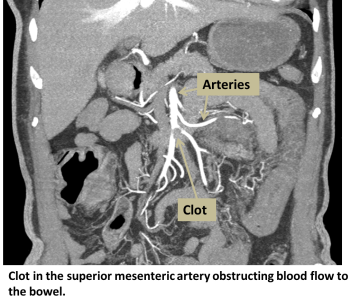Gastrointestinal Ischemia
Find your care
Our board-certified physicians diagnose and treat many vascular conditions. Call 310-481-7545 to learn more about interventional radiology services.
What is gastrointestinal ischemia?
Gastrointestinal ischemia occurs when the blood supply to the gastrointestinal tract is decreased or cut off. The gastrointestinal tract includes the esophagus, stomach, small intestines, colon (large intestines), and rectum. Decreased blood flow decreases the amount of oxygen available to these organs, which can lead to cell death and permanent organ damage. Colonic ischemia is the most common type of gastrointestinal ischemia.
The blood supply to the gastrointestinal tract comes from three branches of the aorta: the celiac artery, the superior mesenteric artery, and the inferior mesenteric artery. Because there is overlap between the areas that these arteries supply, the arteries can try to compensate for blockages in other areas. However, uncompensated areas will suffer more damage from decreased blood flow.

Risk Factors
Blood loss, decreased blood flow, narrowing of arteries, or complete blockage of arteries can cause ischemia. Artery narrowing or blockage can result from
- Blood clots
- Atherosclerosis (hardened arteries caused by fatty deposits called plaques)
- Cardiovascular disease
- Aneurysms
- Tumors
- Hernias
- Conditions affecting blood cells or blood vessels
- Hypercoagulable conditions (increased clotting)
- Sickle cell anemia
- Vasculitis
- Lupus
- Certain medications
- Birth control pills
- Estrogen
- Migraine medications
- Drug use
- Cocaine
- Methamphetamine
Symptoms
Symptoms will vary between acute (sudden onset) and chronic gastrointestinal ischemia. People with chronic gastrointestinal ischemia may suffer acute intestinal ischemia attacks, which are life-threatening. Both acute and chronic gastrointestinal ischemia require immediate surgery.
Acute Gastrointestinal Ischemia
- Sudden abdominal pain
- Nausea
- Vomiting
- Fever
- Bloody stool
Depending on the time after the ischemic attack began, there will be frequent bowel movements, no bowel movements, then massive fluid loss into the abdomen leading to shock.
Chronic Gastrointestinal Ischemia
- Abdominal pain or cramps that get worse over time
- Nausea
- Vomiting
- Malnutrition
- Weight loss
- Bloody diarrhea
Diagnosis
In addition to the medical history and symptoms, the physician may perform:
- Abdominal ultrasound
- CT scan
- MRI
- Angiography (X-ray, CT, or MRI with contrast agent to visualize blood vessels)
- Endoscopy (using a camera to look inside the gastrointestinal tract)
- Blood tests
Treatments
The treatment can vary depending on what is limiting blood flow. If calcified plaques have built up on the arterial walls and are obstructing flow angioplasty may be performed. Angioplasty is performed by making a small incision in the groin and advancing a series of tubes and wires to the area of concern under x-ray guidance. The narrowed artery can then be widened with a balloon, a stent may also be placed.
If flow is being blocked because a clot has become lodged in an artery the approach is slightly different. Accessing the area of concern is achieved with a series of wires and tubes under x-ray guidance as described above. Once the area of concern is reached a special catheter can be placed in the clot and clot-busting medication can be delivered to help break up the clot.
For More Information:
For more information or to schedule an appointment with one of our IR physicians, please call 310-481-7545.